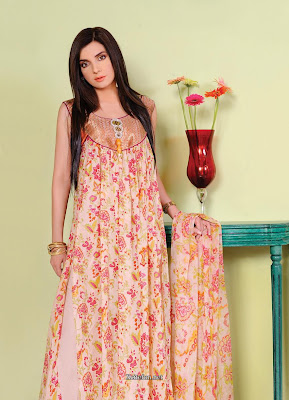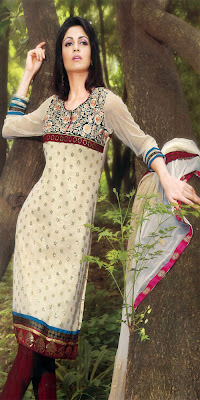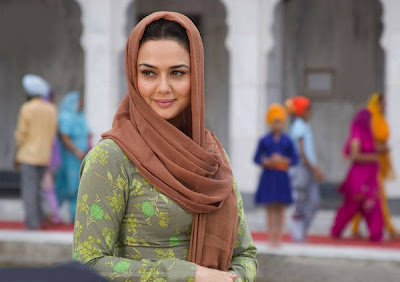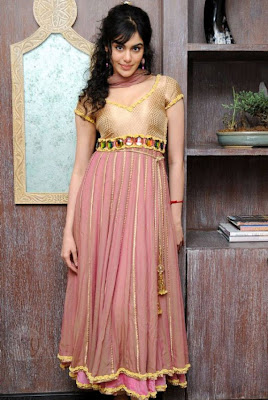Indian Punjabi Suits Biogarphy
source(google.com.pk)
Shalwar are gathered at the waist and held up by a drawstring or an elastic band. The pants can be wide and baggy or more narrow, and even made of fabric cut on the bias.The kameez is usually cut straight and flat; older kameez use traditional cuts, as shown in the illustration above. Modern kameez are more likely to have European-inspired set-in sleeves. The tailor's taste and skill are usually displayed, not in the overall cut, but in the shape of the neckline and the decoration of the kameez. Modern versions of the feminine kameez can be much less modest than traditional versions. The kameez may be cut with a deep neckline, sewn in diaphanous fabrics, or styled in cap-sleeve or sleeveless designs. The kameez side seams may be split up to the thigh or even the waistline, and it may be worn with the salwar slung low on the hips. When a woman wears a semi-transparent kameez (mostly as a party dress), she wears a choli or a cropped camisole underneath it.women wear the salwar kameez, they usually wear a long scarf or shawl called a dupatta around the head or neck. For Muslim women, the dupatta is a less stringent alternative to the chador or burqa (see also hijab and purdah). For Sikh and Hindu women (especially those from northern India, where the salwar kameez is most popular), the dupatta is useful when the head must be covered, as in a Gurdwara or a Temple, or the presence of elders. For other women, the dupatta is simply a stylish accessory that can be worn over one shoulder or draped around the chest and over both shoulders.Shalwar kameez is sometimes known as "Punjabi suit," in Britain[2] and Canada.[3] In Britain, especially during the last two decades, the garment has been transformed from an everyday garment worn by immigrant South Asian women from the Punjab region to one with mainstream, and even high-fashion, appeal.[4]In India, the garment was originally confined to the North, but as a convenient and modest alternative to a sari - and also as one that flatters practically any body-type - it has become popular across the nation. By varying the fabric, color and the level of embroidery and decoration, the salwar-kameez can be formal, casual, dressy, or plain; and it can also be made to suit practically all climates.its royal grandeur, enigmatic feel and female attraction salwar kameez breathes the sighs of history. With its roots deeply seated in the antiquities of medieval India, the origin of Shalwar Kameez still carries the prosperous sartorial chronicle amidst its drop, stitch, luster and really feel.In the hinter lands of Central Asia, which was then below the domination of Iranian and Turkish men and women Shalwar kameez as an expression of Indian ethnicity made its presence felt for the quite initial time. The standard practice of the Iranian and Turkish folks were placing in saggy trousers even though drawing it tight with strings. Investigation says that this sample was indeed the progenitor of today's shalwar kameez. Therefore this era really states the origin of shalwar kameez.salwar is fundamentally a loose trouser, which narrows down a bit towards the bottom. Nevertheless the Iranian and Turkish principle of fastening it with string later on was largely replaced by the principle of elastic belt. On the other hand the kameez is more like a lengthy shirt or tunic like attire, which is additional adorned by a dupatta.
Indian Punjabi Suits Pictures Pics Images 2013
 |
| Indian Punjabi Suits Pictures Pics Images 2013 |
 |
| Indian Punjabi Suits Pictures Pics Images 2013 |
 |
| Indian Punjabi Suits Pictures Pics Images 2013 |
 |
| Indian Punjabi Suits Pictures Pics Images 2013 |
 |
| Indian Punjabi Suits Pictures Pics Images 2013 |
 |
| Indian Punjabi Suits Pictures Pics Images 2013 |
 |
| Indian Punjabi Suits Pictures Pics Images 2013 |
 |
| Indian Punjabi Suits Pictures Pics Images 2013 |
 |
| Indian Punjabi Suits Picture Pics Images 2013 |
 |
| Indian Punjabi Suits Pictures Pics Images 2013 |





No comments:
Post a Comment